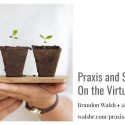The following is a version of my talk for DH2018 that will be given as a part of a roundtable on Digital Humanities Pedagogy and Praxis. Participants on the panel responded to a CFP marking five years since we launched the Praxis Network.
I am Brandon Walsh, the Head of Graduate Programs at the Scholars’ Lab in the University of Virginia Library in the United States. Today I want to talk about a tension I see in DH pedagogy between the hands-on, student-driven instruction that we’re discussing here as part of the Praxis Network and the scale at which we can offer it. Can we take what started small and scale it up in an ethical and informed way? In particular, I want to suggest that “small” investments in pedagogy driven by students are worth it, that we should resist uncritical calls to scale up the reach of our praxis, and that we can best measure the growth of our programs by the degree to which our students are empowered to become engaged, generous teachers in their own right.
My own local context for this talk is the Scholars’ Lab’s Praxis Program, which offers a targeted digital humanities injection during the early years of a student’s graduate work. In the Praxis Program each year, staff and faculty work alongside a student cohort to theorize a new digital intervention and to train the students to implement it themselves. We shift from a series of workshops and discussions in the fall semester to a lab model in the spring, from the staff in front of the room to all of us working together to get a thing done. Funding for the program comes from the library in the form of teaching releases for the students, and I’m happy to talk more about these practical details in the Q&A. The program aims to equip graduate students with the skills and ethos necessary to thrive when carrying out collaborative, open work that might happen on or off the tenure track, and, drawing upon the pedagogical theories of Cathy Davidson, Paolo Freire, Bethany Nowviskie, and others, we do this by putting the students in charge, allowing them as much as possible to decide what they work on and how they’ll work on it.
Read the full post here.

